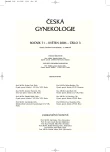Embryo Quality Evaluation according to the Speed of the first Cleavage after IntraCytoplasmic Sperm Injection (ICSI)
Authors:
J. Březinová 1; M. Svobodová 1; I. Oborná 1; H. Fingerová 1; J. Dostál 1; M. Kršková 2
Authors‘ workplace:
Centrum asistované reprodukce, Por. -gynekologická klinika FN a LF UP, Olomouc
přednosta prof. MUDr. M. Kudela, CSc.
1; Centrum výpočetní techniky UP, Olomouc, ředitel RNDr. F. Zedník
2
Published in:
Ceska Gynekol 2006; 71(3): 204-208
Category:
Original Article
Overview
Objective:
To evaluate morphological parameters of embryos obtained in the process of ICSI.
Design:
A prospective study.
Setting:
Centre of Assisted Reproduction, Dept. of Obstetrics and Gynecology, Palacký University Medical School, Olomouc.
Methods:
In the present study 1116 embryos developing after ICSI (IntraCytoplasmic Sperm Injection) procedure in the period of 2001-2004 were evaluated. The beginning of the mitotic cleavage was assessed within the interval of 22–27 hours after insemination. The embryos were divided into three groups according to the speed of their division as Early Cleavage (EC) embryos, where two blastomeres were present at the time of assessment, Break Down ProNuclei stage (BDPN) where the pronuclei had already disappeared, and ProNuclei (PN) embryos, where both pronuclei were still present. In these groups the degree of fragmentation was evaluated on day two of cultivation and embryos were divided into four categories as: A – regular blastomeres, without fragmentation, B - irregular blastomeres or fragmentation below 30%, C - fragmentation 30 - 50%, D - fragmentation above 50%. The speed of further cleavage and average number of blastomeres were evaluated on day two and three of cultivation. Statistical analysis was preformed at the Palacký University Computer Centre. The χ2 test and t-test for independent samples were used.
Results:
EC embryos were found in 37.4%, BDPN in 33.1% and PN in 29.5%. The degree of fragmentation between evaluated groups of embryos were statistically significant (p = 0.000). EC embryos were less fragmented (p = 0.000), had more blastomeres at the time of evaluation (p = 0.000) and their speed of cleavage was faster (p = 0.000). The cleavage of EC embryos was faster in comparison with the PN group (p = 0.000), but there were no significant differences between the EC and BDPN groups on day two of cultivation. On day three significant differences were found also between the EC and BDPN groups (p = 0.000). The embryonic developmental arrest was found only in PN embryos.
Conclusion:
The speed of the first cell cleavage is a useful additional criterion for the embryo selection for embryotransfer. EC embryos usually have better morphology and more blastomeres than the BPDN and PN ones.
Key words:
„early cleavage“ embryos, embryo selection, embryo quality and viability, in vitro fertilization
Labels
Paediatric gynaecology Gynaecology and obstetrics Reproduction medicineArticle was published in
Czech Gynaecology

2006 Issue 3
Most read in this issue
- Discrepancy of Ultrasound Biometric Parameters of the Head (HC - Head Circumference, BPD - Biparietal Diameter) and Femur Length in Relation to Sex of the Fetus and Duration of Pregnancy
- Serum Antibodies against Annexin V and Other Phospholipids in Women with Fertility Failure
- Intrahepatic Cholestasis of Pregnancy – Four Case Reports
- Prevention of Rh (D) Alloimmunization in Rh (D) Negative Women in Pregnancy and after Birth of Rh (D) Positive Infant
